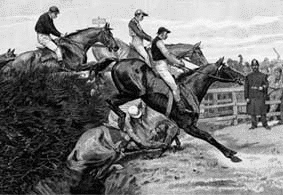

Royal Ascot is without a doubt the world’s most famous race meeting. The name is synonymous with horse racing across the globe, and the event draws around 300,000 spectators every year, making it the most popular European race meeting.
The Royal Family attends every day throughout the five-day event and arrives by horse-drawn carriage. As well as being fundamental to the horse racing calendar, Ascot is also an integral social event and coverage of who attends and what they are wearing is as important as the results of the races.
This has meant that people can often attend for two very different reasons, to the dismay of some of the more hardcore racing fans.
The Royal Enclosure has a strict dress code, which specifies that women should not have bare midriffs or shoulders and must wear a hat, and men must wear morning dress and top hat.
The dress code outside the Royal Enclosure is not as strict as this, but formal attire is preferred.
Royal Ascot History
There has always been a great tie between the Ascot Race and The Royal Family.
Queen Anne founded the racecourse in 1711 after she stumbled upon the area whilst out riding and decided that it would be a perfect spot for a racecourse.
After the course was built, the first race was held on 11th August 1711 and races were frequently held at the spot throughout Queen Anne’s reign.
The Queen Anne Stakes continue to be held today at Royal Ascot in memory of the founder of the racecourse.
However, after her death and coronation of King George I, the course was left idle due to the King’s disregard for sport.
Racing did return to the course in later generations, with it promptly becoming one of the most important race meeting venues in the country.
The exact date of the first royal meeting is not known, but the first four-day event was held in 1768. Many, however, do not think that the meeting as it is known today took shape until 1807, when the Gold Cup was introduced. Soon after, this race became the pinnacle event of the meeting.
In 1813 an Act of Enclosure was passed by Parliament, which stated that Ascot Heath was property of the crown but would be kept and used as a racecourse for the public, guaranteeing permanent racing at the course for the future.
The first royal carriage procession into the meeting was initiated by King George IV in 1825 and has remained a tradition until the present day. There were no other meetings apart from the Royal meeting held at Ascot Racecourse until 1939.
In 2004 the racecourse was closed for refurbishment and no meetings were held for two years. In 2006 the course was reopened by the Queen at the start of Royal Ascot.
Running the race
Although Royal Ascot is officially founded and run by the crown, the actual administration for the race has been appointed to a third party who is a representative chosen by the monarch.
In 1913 the Ascot Authority was established by an Act of Parliament, with the crown’s representative becoming chairman of this authority.
Ascot Racecourse remained a private company until 2001 when it became Ascot Racecourse Ltd, which is now responsible for running the event.
The races scheduled
There are thirty races in total held throughout the whole of the Royal Ascot meeting. The names of the races show the close connection between the race meeting and the Royal Family.
There are six races on the first day: the Coventry Stakes, King’s Stand Stakes, St James’ Palace Stakes (the feature race of the day and the first Group 1 of the week), the Queen Anne Stakes, the Ascot Stakes, and finally the Windsor Castle Stakes.
The Jersey Stakes and the Windsor Forest Stakes start the second day, but the two feature races of the day, which the majority of spectators are interested in, are the Prince of Wales Stakes and the Royal Hunt Stakes. These are top-quality races and are often among the highlights of the whole week.
The Queen Mary Stakes and the Sandringham Handicap Stakes finish the day.
The six races on the third day, also known as Ladies’ Day, kick off with the Norfolk Stakes, followed by the Ribblesdale Stakes.
The feature race of the day, and for some the whole of Royal Ascot, is the Royal Ascot Gold Cup as it is the longest flat race of the meeting and therefore always provides great entertainment.
The three other races of the day are the Britannia Stakes, the Hampton Court Stakes and the Buckingham Palace Stakes.
The races on the fourth day are all entered by horses with great stamina and therefore the day is often intensely exciting.
The Albany Stakes and the King Edward VII Stakes are the warm-up for the feature race of the day, the Coronation Stakes.
This is followed by the Wolferton Handicap Stakes, but it is the next two races, the Queen’s Vase and the King George V Stakes, which pull in a large crowd.
The final day sees the start of the weekend, starting with the Chesham Stakes and the Hardwicke Stakes.
But it is the third race, the Golden Jubilee Stakes, which is the feature race of the day.
The event is finished with the Wokingham Stakes, the Duke of Edinburgh Stakes and, lastly, the Queen Alexandra Stakes.
All UK bookmakers are offering free bets and various offers during the festival. Bet365 horse racing service is unmatched, and another bookmaker worth your attention is Unibet.








